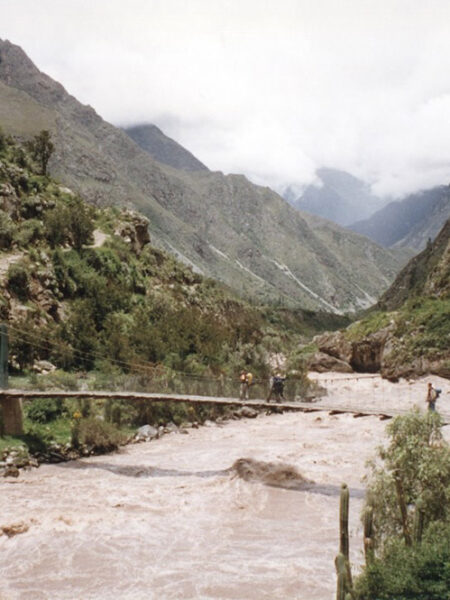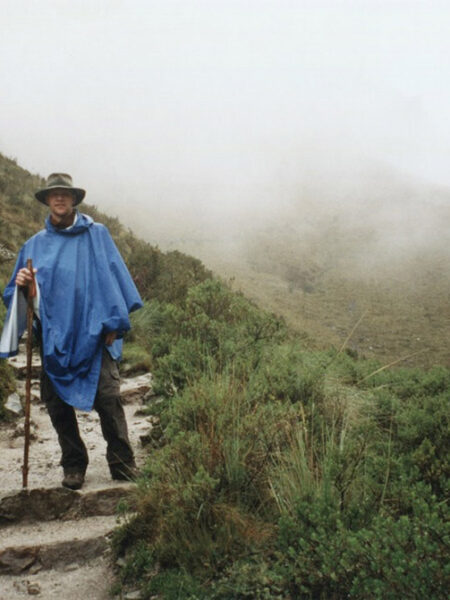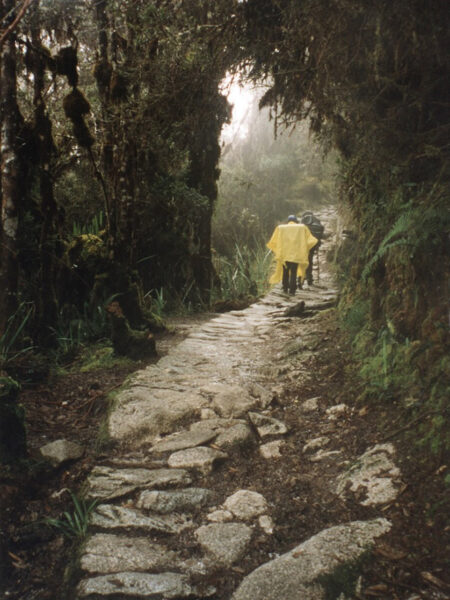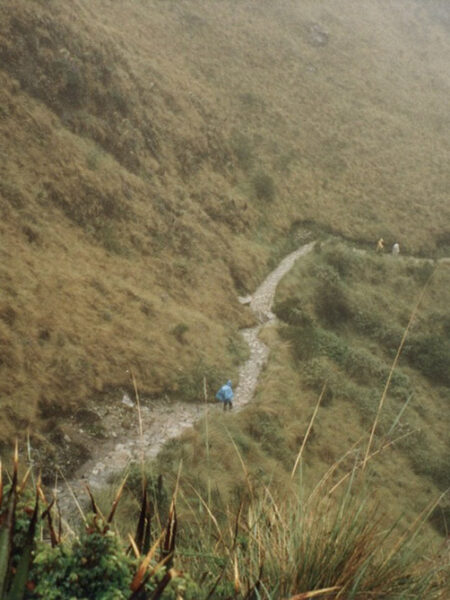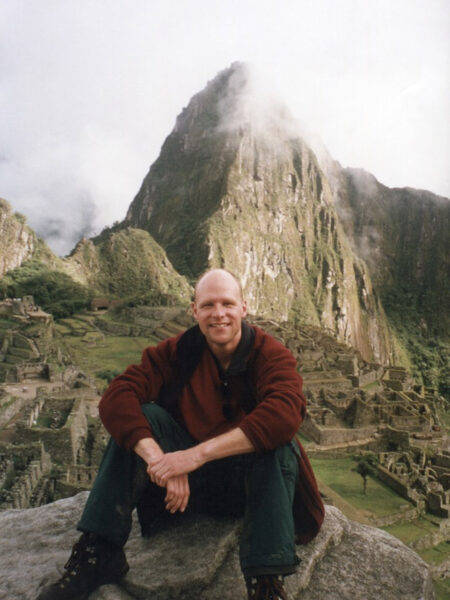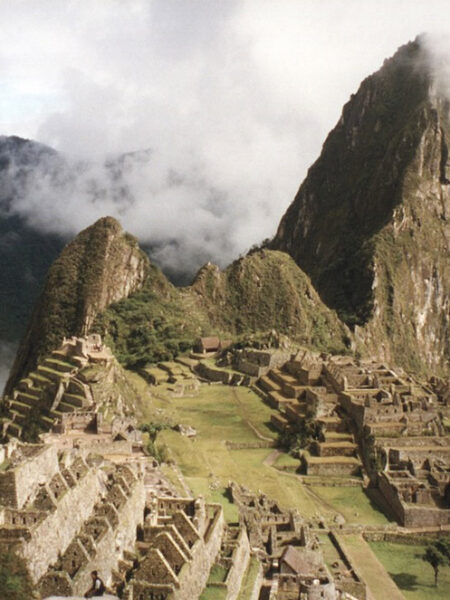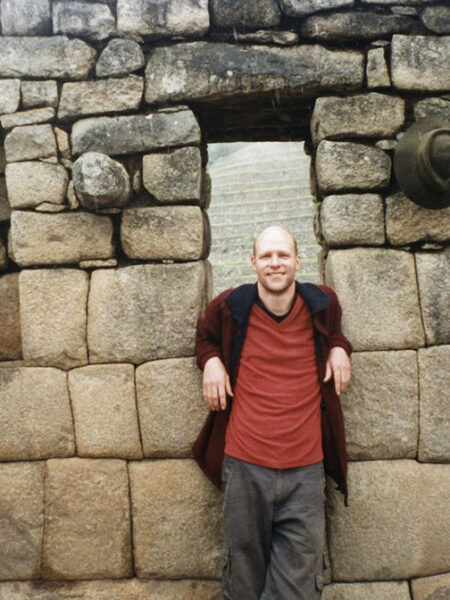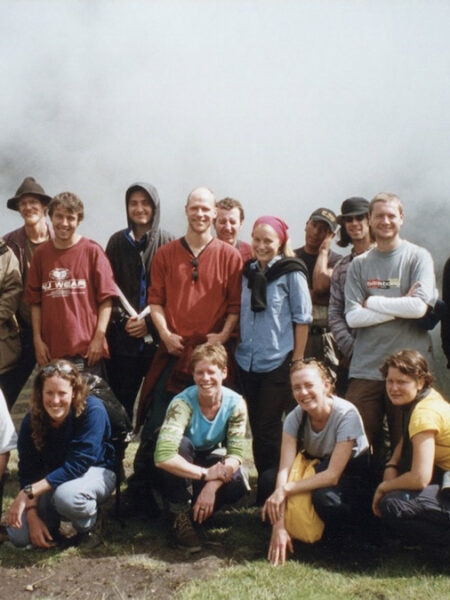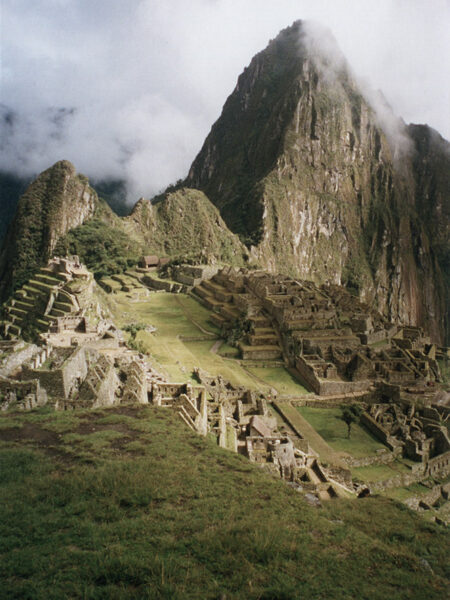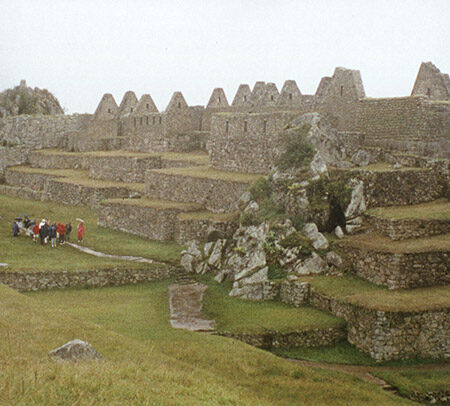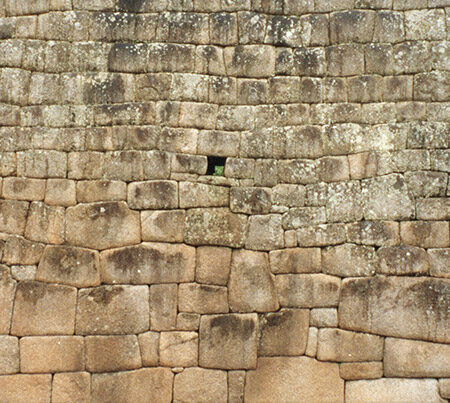Tip No.1: when planning to do the Inca Trail, do it out of the rainy season! That said the mist and rain is very atmospheric, especially when stumbling upon ruined cities in the jungle, there are not many people on the trail, and there is the satisfaction of doing it at a challenging time.
L and M and I had a great group of 15 others; several English, three Swiss, one Australian (who unfortunately had to turn back due to altitude sickness), an Israeli, a Canadian and a couple of Venezuelans. And our effusive guide. The tour company (SAS) was pretty good and the food excellent, the tents dry for the most part and everything pretty professional.
The first day was pretty easy and the weather not too bad to start. Headed off from ‘Km88’ on the rail line (after stopping in Ollantaytambo to buy coca leaves and a walking stick) and across the raging brown Urubamba river and up into the hills. About 6 hours over hills and into the Cusichaca river valley, stopping to look down on the ruined Inca agricultural city of Patallaqta and for lunch. Porters go ahead with all the camp gear to set up – these guys are amazing, trudging along on low wages and sandals made of car tyres. These days there are checkpoints where their load is limited to 25kg, but I’m sure some are carrying far more.
First camp was at the head of a sloping valley near the village of Wayllabamba at 3000m – spectacular view of distant snowpeaks. Everyone getting along well straight away. M had a bad cold (the big brother of which I’m enjoying now I think) but soldiered on the whole trek without complaining.
Next day the rain became our almost constant companion. This was the toughest day and we started up after a 6am wakeup and breakfast, climbing and climbing and climbing for 3 and a half hours to Dead Woman’s Pass at 4200m. The last stretch up a seemingly endless Inca staircase was very very tough for everybody. Despite no long views today and the next day due to fog, it was very satisfying to be up there at the highest point of the walk, and the Snickers bar I had certainly tasted better than any other chocolate bar I’ve ever had! Half of the day I was chewing coca leaves which seemed to ease the aches somewhat. You take a wad of leaves, add a bit of black charcoal-like llibta, and stuff the lot into the cheek and chew. Makes your mouth go numb and acts as a mild stimulant. While I’m on the subject, the US is apparently perfecting a fungus they plan to use to destroy coca leaves, as cocaine is a highly specialised derivative of the leaves. In the process they would destroy a plant that has been a vitally important part of the culture of this part of the world for several thousand years. A disgusting example of short-sighted overkill that betrays a total lack of understanding of other cultures. End of rave!
Anyway, back to the Trail. A few hours down into the Pacamayo river valley, wet and cold, beautiful waterfalls and a big muddy campsite by a raging river. By the way, unlike a large part of the group I did the day without the help of extra porters, carrying my own backpack with my sleeping bag and mattress! Didn’t want to cheat!
Rain rain rain. A long third day, starting up Inca steps (now completely original; some of the steps before were restored), a stop at a small tower ruin called Runkuracay, then up to the second pass at 4000m. Past shallow high lakes, down into atmospheric jungle, the stone trail clinging to stone faces and step hillsides. To the spectacular ruin of Sayamarca, clinging to a stone spur and reached by a steep flight of stone steps. Surrounded by fog and the jungle and the Inca city, huddled under my broad brimmed hat, fufilling my Indiana Jones fantasies!
After lunch, some amazing jungle sections of trail; moss-covered trees, carpets of thick moss, a swampy clearing with the stone trail winding through it (like the Dead Marshes in The Lord of the Rings), an Inca tunnel cut through a cleft in the rock. A slow climb up to the last pass, down to the ruin of Phuyupatamarca in the fog, a spectacular steep jungle staircase down into the gorge of the Urubamba river, and here at last the fog cleared somewhat and I could see the river below and the ruins of Winay Wayna clinging to a spur.
Turning off the main trail, a long switchbacking trail down to the last campsite, near a visitor’s centre and restaurant, where the groups doing the trail got together for a few beers, dinner and some dancing!
Before that I walked a short trail to Winay Wayna, the most spectacular ruins yet, a huge ampitheatre of terraces and a town built on a precipitous spur overlooking the river gorge. Those crazy Incas (that became a bit of a catchphrasefor me …) Their city sites sure seem impractical, but they can’t be beat for incredible views. At the end of the town was a tiny little stone ledge where I sat, a 200m drop into the jungle below, soaking in the beauty of the spot.
The next day was a 4am start to walk the last stretch to Macchu Picchu. We all hoped for a clearing of the weather, but unfortunately we climbed the last steep stairway up to the Sun Gate at the top of the ridge and, standing in the drizzle, were met by an inpenetrable wall of white fog where there should have been a panorama of Macchu Picchu.
But it was still early. We walked down towards the city, and finally, at an area of terracing near where the classic shot of Macchu Picchu is taken, I sat on a rock and watched the city slowly take shape out of the fog, reminding me of watching the Taj Mahal form out of the morning mist in Agra.
It looked like it would continue to clear, so we went through the bureaucratic procedures, checked in our bags, sat in the cafe for a bit, and then headed back up the hill as the sun came out. At 9am, before all the tourists had arrived, I was back on the hill overlooking the city, the weather crystal clear, the sun out, and the astounding panorama of the city and the river gorge and the mountain of Wayna Picchu spread out before me. What a sight; right up there with my first view of the pyramids. We were so lucky to have a few hours of perfect clear weather – a reward for our effort perhaps.
A kind tourist took photos of our group, and while the others followed the guide around the city, I had to experience the city alone and wandered by myself with my ‘Exploring Cuzco’ book in hand as a guide for several hours. The city is undescribable and fascinating – I took about 55 photos and explored every nook and cranny. It was easy to imagine the city teeming with life, the terraces dotted with colourfully dressed workers, the priests performing arcane rituals on the stone altars, people having conversations in the wide grassy square.
In a few hours the rain had started and the fog had closed in along with hordes of poncho clad tourist groups. I took the bus down to Aguas Calientes, met the rest of the group for lunch, then a few of us availed ourselves of the hot springs from which the town gets its name. Aching bones got some relief. A long train and bus ride back to Cuzco.


